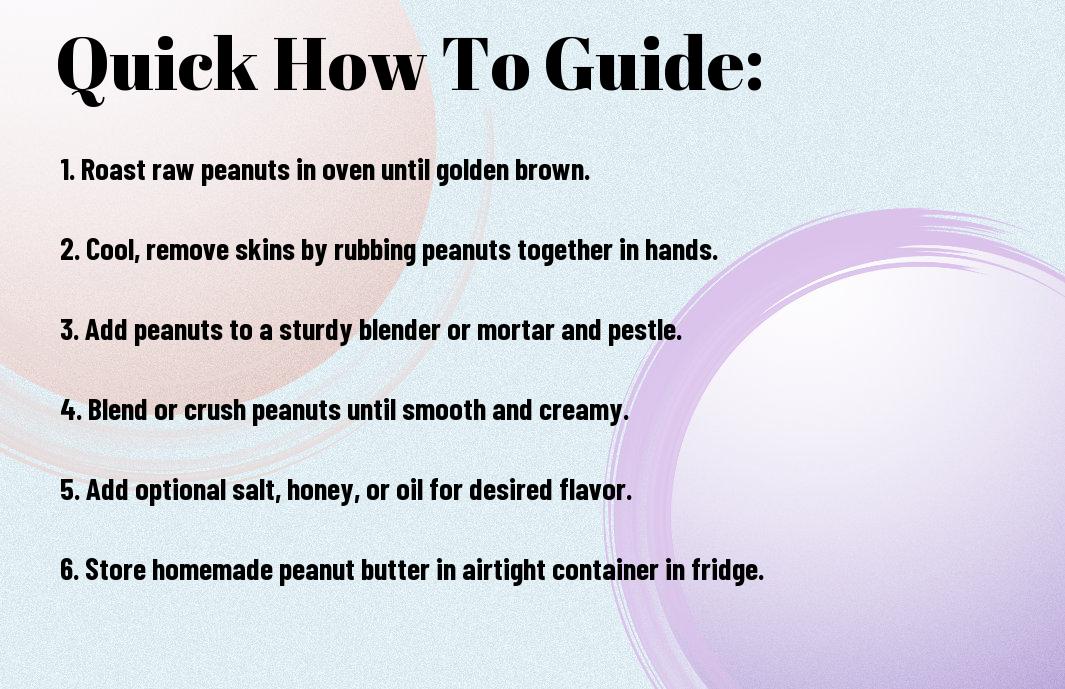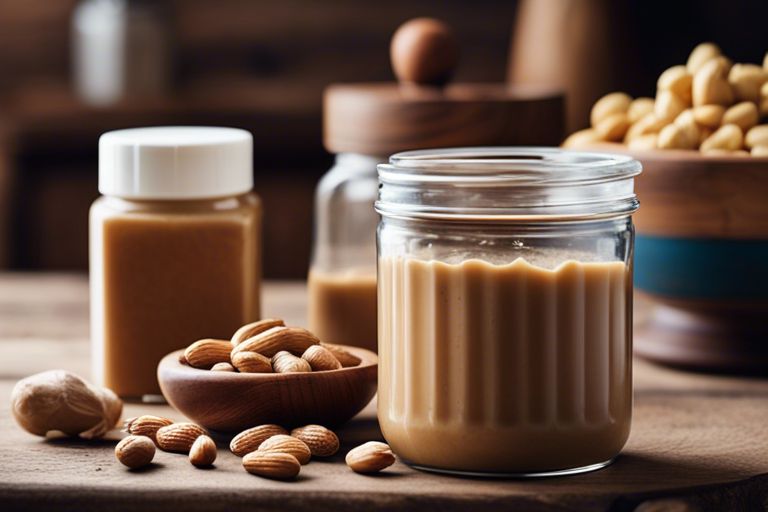There’s no need to fret if you don’t have a food processor at home – you can still whip up delicious homemade peanut butter with just a few simple steps and tools. In this guide, we’ll walk you through an easy method to make creamy, flavorful peanut butter without the need for a fancy appliance. Get ready to elevate your toast, smoothies, and snacks with your very own homemade peanut butter!
Key Takeaways:
- Use a high-powered blender: To make peanut butter without a food processor, a high-powered blender can be a great alternative.
- Add oil for smoother consistency: Adding a small amount of oil while blending can help achieve a smoother and more spreadable texture for your homemade peanut butter.
- Patience is key: Making peanut butter without a food processor may take a bit longer, so patience is imperative during the blending process to achieve the desired consistency.

Understanding the Basics of Making Peanut Butter
To achieve the perfect homemade peanut butter, it is necessary to understand the basics of the process. By knowing the key factors that affect peanut butter consistency and choosing the right peanuts, you can make a smooth and flavorful spread that rivals store-bought varieties.
Factors Affecting Peanut Butter Consistency
- Roasting level of the peanuts
- Amount of oil used
- Blending time
Knowing how these factors influence the texture of the peanut butter will help you adjust your recipe accordingly to achieve the desired consistency.
Choosing the Right Peanuts for Homemade Peanut Butter
An important factor in making homemade peanut butter is selecting the right peanuts. Opt for fresh, high-quality peanuts with a higher oil content for a creamier consistency. You can choose between raw or roasted peanuts depending on your flavor preferences.
With a variety of peanuts available in the market, look for options that are free from additives and preservatives to ensure a natural and healthy spread. Experiment with different types of peanuts to find the perfect balance of flavor and texture for your homemade peanut butter.
Preparing Your Ingredients
Roasting Peanuts for Enhanced Flavor
Some recipes call for roasted peanuts to enhance the flavor of the peanut butter. To roast your peanuts, simply spread them out in a single layer on a baking sheet and bake them in a preheated oven at 350°F for about 10-15 minutes until they are golden brown. Keep an eye on them to prevent burning.
Cooling Peanuts for Easy Grinding
Little Have your roasted peanuts cooled completely before attempting to grind them. This will not only make the grinding process easier but will also prevent the oils from separating too quickly, ensuring a smoother consistency in your peanut butter.
Preparing
Optional: Adding Salt or Other Ingredients
Salt or If you desire, you can add a pinch of salt to enhance the flavor of your peanut butter. Additionally, you can add other ingredients such as honey, maple syrup, or even cocoa powder to customize your peanut butter to your taste preferences.
To
To incorporate these additional ingredients, simply add them to the ground peanuts during the blending process. Make sure to taste the mixture as you go to adjust the seasoning or sweetness according to your liking.
Grinding Peanuts Without a Food Processor
Despite not having a food processor on hand, there are still several ways you can grind peanuts to make delicious homemade peanut butter. From using a blender to a hand grinder or mortar and pestle, you have options to choose from based on the tools available in your kitchen.
Using a Blender: Tips and Tricks
Assuming you have a blender at home, you can still make peanut butter without a food processor. When using a blender, it’s crucial to pulse the peanuts in short bursts to prevent them from turning into peanut dust. You may need to stop and scrape down the sides of the blender jar to ensure an even grind.
- Start by chopping the peanuts into smaller pieces before placing them in the blender.
- For a smoother consistency, add a bit of oil to the peanuts while blending.
Though using a blender may take a bit more time and effort, the end result will be just as delicious as if you had used a food processor. Remember to be patient and persistent in achieving the desired peanut butter texture.
Grinding with a Hand Grinder or Mortar and Pestle
Any kitchen tools that allow you to crush and grind peanuts can be used to make peanut butter. A hand grinder or mortar and pestle are excellent alternatives to a food processor or blender. These manual tools give you more control over the grind, allowing you to achieve your preferred peanut butter consistency.
Grinding peanuts with a hand grinder or mortar and pestle may require more physical effort compared to using electric appliances. However, the traditional method can be quite rewarding and provide a sense of accomplishment knowing you made peanut butter from scratch.
The Old-Fashioned Way: Grinding by Hand
Assuming you don’t have a blender, food processor, hand grinder, or mortar and pestle, grinding peanuts by hand is still a viable option. All you need is a bit of elbow grease and perseverance to crush the peanuts into a paste-like consistency. This method may take more time and effort, but the end result is worth it.

Achieving the Perfect Consistency
How to Check for Desired Smoothness
For achieving the perfect peanut butter consistency without a food processor, it is necessary to check the smoothness of the mixture as you blend it. Stop blending at intervals to test the texture. You can do this by taking a small amount of the mixture and rubbing it between your fingers to feel for any gritty or coarse particles.
Factors That Affect Peanut Butter Consistency
Perfecting the consistency of peanut butter can be influenced by several factors including the type of nuts used, the level of oil in the nuts, and the duration of blending. To achieve a creamy and spreadable texture, it is important to consider the natural oils present in the nuts to reach the desired consistency.
- The type of nuts being used
- The amount of oil in the nuts
- The duration of blending
This will help you understand how different factors impact the outcome of your homemade peanut butter. Adjusting these factors will help you achieve your preferred consistency that suits your taste and preference.
Troubleshooting Common Issues
For troubleshooting common issues when making peanut butter without a food processor, you may encounter problems like a dry or crumbly texture. This can happen if the nuts are not releasing enough natural oils during blending or if the mixture is overblended.
Understanding how these issues arise can help you make adjustments during the blending process to rectify the texture and achieve a smooth and creamy peanut butter.
Storing and Enjoying Your Homemade Peanut Butter
Many homemade peanut butter enthusiasts enjoy the satisfaction of crafting their creamy spread from scratch. Once you’ve made your delicious peanut butter without a food processor, it’s vital to store it properly to maintain its freshness and flavor.
Storage Options: Glass Jars and Beyond
Little Mason jars are a popular choice for storing homemade peanut butter. These airtight containers help preserve the spread for an extended period. You can also use other glass jars or food storage containers with tight-fitting lids. Be sure to store your peanut butter in a cool, dark place, away from direct sunlight to prevent oil separation.
Tips for Maintaining Freshness
One crucial tip for maintaining the freshness of your homemade peanut butter is to stir it well before each use. This helps redistribute the oils and ensures a consistent texture. Additionally, storing your peanut butter in the refrigerator can help extend its shelf life and prevent any rancidity.
- Avoid introducing moisture into the jar to prevent mold growth.
- Use a clean, dry utensil each time to scoop out the peanut butter.
- Any leftover peanut butter can also be frozen for longer storage.
Creative Ways to Use Your Fresh Peanut Butter
With your freshly made peanut butter, the possibilities are endless. From classic PB&J sandwiches to decadent peanut butter desserts, there are countless ways to enjoy your homemade spread. Whether spread on toast, mixed into smoothies, or used as a dip for fruits, homemade peanut butter adds a delicious touch to any dish.
- Try incorporating peanut butter into your morning oatmeal or yogurt for a protein-packed breakfast.
- Butter
Common Challenges and Solutions
Dealing with Oil Separation
The most common challenge when making peanut butter without a food processor is dealing with oil separation. This happens when the natural oils in the peanuts separate and rise to the top, leaving a dry and thick mixture at the bottom.
Overcoming Grinding Difficulties
The key to making peanut butter without a food processor is to ensure that your peanuts are finely ground to achieve that smooth and creamy texture. If you’re facing difficulties grinding the peanuts, try adding a little bit of oil (such as vegetable or coconut oil) to help with the process.
With a little bit of patience and frequent scraping down the sides of the blender or grinder, you can eventually achieve the desired consistency for your homemade peanut butter.
Addressing Texture Issues
Addressing texture issues is another common challenge when making peanut butter by hand. If your peanut butter turns out to be too thick or too runny, you can adjust the consistency by adding more peanuts or oil until you reach the desired texture.
Separation of oil and peanuts is a common issue when making peanut butter without a food processor. To address this, simply mix the separated oil back into the peanut butter until it reaches a smooth and consistent texture again.
Summing up
On the whole, making peanut butter without a food processor is an achievable task with a few creative alternatives. Using a blender, a mortar and pestle, or even a coffee grinder can all yield creamy and delicious homemade peanut butter. It may require a bit more effort and time, but the end result is definitely worth it.
Experimenting with different add-ins like honey or spices can further enhance the flavor of your homemade peanut butter. Don’t be afraid to get creative and have fun with the process. With a little patience and some basic kitchen tools, you can enjoy the satisfaction of making your own peanut butter from scratch without a food processor.
FAQ
Q: Can I make peanut butter without a food processor?
A: Yes, you can make peanut butter without a food processor using a blender, a mortar and pestle, or a food chopper.
Q: What ingredients do I need to make peanut butter?
A: To make peanut butter, you will need roasted peanuts, salt (optional), sweetener (optional), and oil (optional).
Q: How do I make peanut butter in a blender?
A: To make peanut butter in a blender, add roasted peanuts to the blender and blend on high until smooth, scraping down the sides as needed. Add oil, salt, and sweetener if desired, and blend again until well combined.
Q: How can I make peanut butter using a mortar and pestle?
A: To make peanut butter using a mortar and pestle, crush the roasted peanuts in batches until they form a smooth paste. Add salt, sweetener, and oil if desired, and continue mashing until well combined.
Q: What is the shelf life of homemade peanut butter?
A: Homemade peanut butter can be stored in an airtight container in the refrigerator for up to two weeks. Stir before using as the natural oils may separate.
